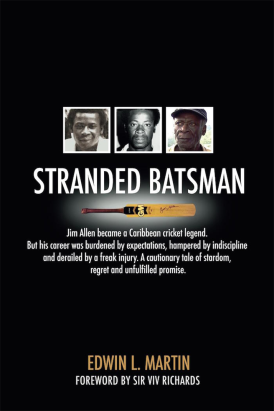Stranded Batsman
Martin Chandler |Published: 2017
Pages: 278
Author: Martin, Edwin
Publisher: Private
Rating: 4 stars

The front cover of Stranded Batsman describes Jim Allen as a “Caribbean cricket legend”. Despite that the name rang no bells for me, so before I went any further I took a quick look at Allen’s record. His First Class career lasted just over ten years and comprised 55 matches. He scored a fraction over 3,000 runs at an average of a tick over 34. Not bad, but hardly the stuff of legend. My inclination before I had opened the book was to wonder whether Edwin Martin was guilty of hyperbole.
By the time I had finished reading Martin’s prologue, however, that particular charge had been dismissed. Even at that early stage it was quite clear that Allen, still the finest cricketer to have emerged from the island of Montserrat, merited the description. His story is a fascinating one and to add to the book’s merits its author is a fellow Montserratian who weaves into his subject’s story a history of the island, severely affected as it has been in living memory by hurricanes and volcanic activity, as well as much about the lifestyle of the few thousand people who live there.
Jim Allen was a contemporary of Sir Vivian Richards. As Martin illustrates, when Richards made his Test debut in 1974 his First Class record was not as good as Allen’s. Nothing more clearly illustrates just what Allen might have achieved had he hailed from Antigua or one of the bigger islands.
It is clear that watching Allen bat was every bit as enjoyable for onlookers as watching the ‘Master Blaster’ himself. Allen spent some time in the northern England leagues in the 1970s, and a couple of First Class counties had a good look at him. He may not have done quite enough to impress them, but his skills were such that Clive Lloyd was happy to put his name in Kerry Packer’s frame when Alvin Kallicharran was unable to take up an offer from World Series Cricket. The irony, not lost on Martin, is that had Allen not gone to Australia he would almost certainly have got that coveted Test cap and the opportunity he craved to show the West Indies selectors that he was their man for the future.
By Montserratian standards Allen returned from Australia a wealthy man, but his batting seemed to stall. Not too long afterwards, in 1981 and still only 29, he suffered a serious eye injury when an innocuous delivery on a practice wicket leapt at him. Surgery was needed to repair the damage. He was never the same batsman again and a couple of years later he retired.
His own playing career over, Allen desperately wanted the job of national coach. But a few years later, when the country could at last afford to appoint one, he didn’t get the job. He spent a few years as a prison officer but, with a bitterness fuelled by alcohol, his life spiralled down until in 2013 concerned friends had to remove the 62-year-old from the squalid conditions in which he lived and into a new assisted living facility.
Martin has done a splendid job of reconstructing Allen’s story. As well as Allen we follow the paths of his parents, his siblings and his son, Davon Williams, who had a brief First Class career himself. We learn about the family dynamics and, because Allen was prepared to talk to Martin at length, much of the man himself. Early on in that prologue Martin admits to having hero-worshipped Allen as a child, usually an unhelpful position from which to start writing a biography, so Martin must be given great credit for not allowing sentiment to cloud his objectivity.
The story that Martin tells is a thought provoking one. It is, his having spent the bulk of his working life as an editor, very well written and thoroughly researched. With the exception of one former teammate who declined the invitation everyone important in Jim Allen’s life who is still alive was interviewed, and Sir Vivian himself provides a generous foreword.
In terms of the production of the book I am assuming from its appearance that it has been self-published via Amazon. The result is not entirely satisfactory although, given Martin’s training, I suspect it is as well done as is possible in the circumstances. The only real disappointment is the appearance of some photographs in what is otherwise an excellent selection. That said one that suffers particularly from being poorly reproduced, of Allen executing a cover drive on a club ground in England, gains an ethereal appearance that gives it a power and impact way beyond that which the original full colour image would have provided and the result is something that, quite frankly, I would be very happy to have hanging on my wall.







Leave a comment